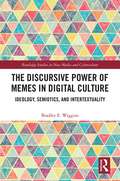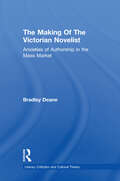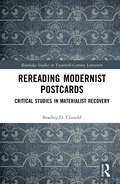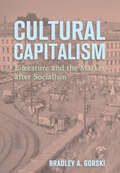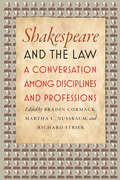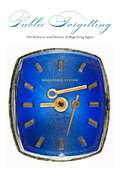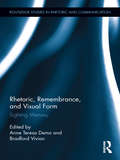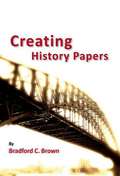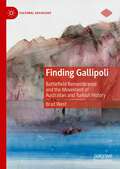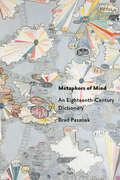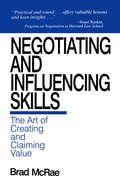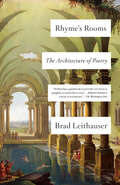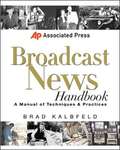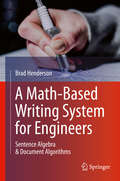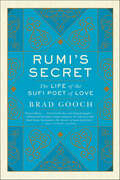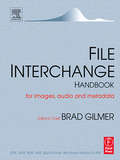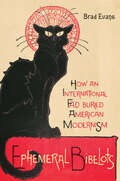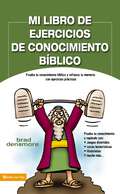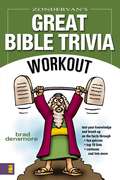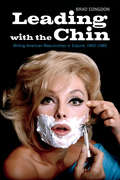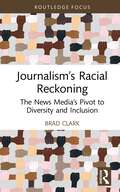- Table View
- List View
The Discursive Power of Memes in Digital Culture: Ideology, Semiotics, and Intertextuality (Routledge Studies in New Media and Cyberculture)
by Bradley E. WigginsShared, posted, tweeted, commented upon, and discussed online as well as off-line, internet memes represent a new genre of online communication, and an understanding of their production, dissemination, and implications in the real world enables an improved ability to navigate digital culture. This book explores cases of cultural, economic, and political critique levied by the purposeful production and consumption of internet memes. Often images, animated GIFs, or videos are remixed in such a way to incorporate intertextual references, quite frequently to popular culture, alongside a joke or critique of some aspect of the human experience. Ideology, semiotics, and intertextuality coalesce in the book’s argument that internet memes represent a new form of meaning-making, and the rapidity by which they are produced and spread underscores their importance.
Making of the Victorian Novelist: Anxieties of Authorship in the Mass Market (Literary Criticism and Cultural Theory)
by Bradley DeaneFirst Published in 2003. Routledge is an imprint of Taylor & Francis, an informa company.
Masculinity and the New Imperialism
by Bradley DeaneAt the end of the nineteenth century, the zenith of its imperial chauvinism and jingoistic fervour, Britain's empire was bolstered by a surprising new ideal of manliness, one that seemed less English than foreign, less concerned with moral development than perpetual competition, less civilized than savage. This study examines the revision of manly ideals in relation to an ideological upheaval whereby the liberal imperialism of Gladstone was eclipsed by the New Imperialism of Disraeli and his successors. Analyzing such popular genres as lost world novels, school stories, and early science fiction, it charts the decline of mid-century ideals of manly self-control and the rise of new dreams of gamesmanship and frank brutality. It reveals, moreover, the dependence of imperial masculinity on real and imagined exchanges between men of different nations and races, so that visions of hybrid masculinities and honorable rivalries energized Britain's sense of its New Imperialist destiny.
Rereading Modernist Postcards: Critical Studies in Materialist Recovery (Routledge Studies in Twentieth-Century Literature)
by Bradley D. ClissoldInformed by both new and old media theory, materialist approaches to the study of everyday objects, and a series of close readings that chart the critical history of postcard use in the fiction and correspondence of Ernest Hemingway, Ring Lardner, James Joyce, and Wilfred Owen, this book locates and attempts to rediscover lost, misplaced, and neglected postcard materialities, as they relate to the archiving, editing, publishing, and fictional repurposing of postcards across Anglo-American Literary Modernism (1880-1939). It argues that postcards need to be recognized as important early twentieth-century communication technologies and distinctly modernist textualities, composed of multimedia, recto–verso intertextualities. Moreover, their material limitations encourage users to inscribe messages often in fragmented language forms and innovative cultural shorthands (a.k.a. postcardese). This study redresses the ongoing, widespread scholarly neglect of signifying postcard materialities in modernist studies and the editorial silencing of postcard features in collections of published author correspondence. It also stresses that for these four literary figures of modernism, the material choice of a postcard for communicating is always as much the (meta)message, as any of the signifying materialities they carry uploaded onto their platforming surfaces.
Cultural Capitalism: Literature and the Market after Socialism (NIU Series in Slavic, East European, and Eurasian Studies)
by Bradley A. GorskiCultural Capitalism explores Russian literature's eager embrace of capitalism in the post-Soviet era. When the Soviet Union fell, books were suddenly bought and sold as commodities. Russia's first bestseller lists brought attention and prestige. Even literary prizes turned to the market for legitimacy. The rise of capitalism entirely transformed both the economics and the aesthetics of Russian literature. By reconstructing the market's influence on everything from late-Soviet paper shortages to the prose of neoimperialism, Cultural Capitalism reveals Russian literature's exuberant hopes for and deep disappointments in capitalism. Only a free market, it was hoped, could cure endemic book deficits and liberate literature from ideological constraints. But as the market came to dominate literature, it imposed an ideology of its own, one that directed literary development for decades.Through archival research, original interviews, and provocative readings of literary texts, Bradley A. Gorski immerses the reader in both the economic and aesthetic worlds of post-Soviet Russian literature to reveal a cultural logic dominated by capitalism. The Russian 1990s and early 2000s saw markets introduced, adopted, and debated at an accelerated pace, all against the backdrop of a socialist past, staging the polemics between capitalism and culture in high drama and sharp relief. But the market forces at the center of the post-Soviet transition are fundamental to cultural trends worldwide. By revealing the complexities of Russia's story, Cultural Capitalism mounts a critique that cuts across national borders and provides a new way of seeing culture in the post-1989 era worldwide.
Shakespeare and the Law: A Conversation Among Disciplines and Professions
by Bradin Cormack, Martha C. Nussbaum, and Richard StrierWilliam Shakespeare is inextricably linked with the law. Legal documents make up most of the records we have of his life, and trials, lawsuits, and legal terms permeate his plays. Gathering an extraordinary team of literary and legal scholars, philosophers, and even sitting judges, Shakespeare and the Law demonstrates that Shakespeare’s thinking about legal concepts and legal practice points to a deep and sometimes vexed engagement with the law’s technical workings, its underlying premises, and its social effects. The book’s opening essays offer perspectives on law and literature that emphasize both the continuities and contrasts between the two fields. The second section considers Shakespeare’s awareness of common law thinking and common law practice, while the third inquires into Shakespeare’s general attitudes toward legal systems. The fourth part of the book looks at how law enters into conversation with issues of politics and community, whether in the plays, in Shakespeare’s world, or in our own world. Finally, a colloquy among Supreme Court Justice Stephen Breyer, Judge Richard Posner, Martha C. Nussbaum, and Richard Strier covers everything from the ghost in Hamlet to the nature of judicial discretion.
Public Forgetting: The Rhetoric and Politics of Beginning Again (G - Reference, Information and Interdisciplinary Subjects)
by Bradford VivianForgetting is usually juxtaposed with memory as its opposite in a negative way: it is seen as the loss of the ability to remember, or, ironically, as the inevitable process of distortion or dissolution that accompanies attempts to commemorate the past. The civic emphasis on the crucial importance of preserving lessons from the past to prevent us from repeating mistakes that led to violence and injustice, invoked most poignantly in the call of “Never again” from Holocaust survivors, tends to promote a view of forgetting as verging on sin or irresponsibility. In this book, Bradford Vivian hopes to put a much more positive spin on forgetting by elucidating its constitutive role in the formation and transformation of public memory. Using examples ranging from classical rhetoric to contemporary crises like 9/11, Public Forgetting demonstrates how, contrary to conventional wisdom, communities may adopt idioms of forgetting in order to create new and beneficial standards of public judgment concerning the lessons and responsibilities of their shared past.
Rhetoric, Remembrance, and Visual Form: Sighting Memory (Routledge Studies in Rhetoric and Communication)
by Bradford Vivian Anne Teresa DemoThis volume offers a multifaceted investigation of intersections among visual and memorial forms in modern art, politics, and society. The question of the relationships among images and memory is particularly relevant to contemporary society, at a time when visually-based technologies are increasingly employed in both grand and modest efforts to preserve the past amid rapid social change. The chapters in this book provide valuable insights concerning not only how memories may be seen (or sighted) in visual form but also how visual forms constitute noteworthy material sites of memory. The collection addresses this central theme with a wealth of interdisciplinary and international approaches, featuring conventional scholarly as well as artistic works from such disciplines as rhetoric and communication, art and art history, architecture, landscape studies, and more, by contributors from around the globe.
Creating History Papers (Students And Professional Concerns)
by Bradford BrownThis reference guide is a must-read for all history students that addresses the howsof history papers, and presents technical information to aid in the process of researching, writing, and documenting.
Shakespeare and Social Theory: The Play of Great Ideas
by Bradd ShoreThis book provides a bridge between Shakespeare studies and classical social theory, opening up readings of Shakespeare to a new audience outside of literary studies and the humanities. Shakespeare has long been known as a “great thinker” and this book reads his plays through the lens of an anthropologist, revealing new connections between Shakespeare’s plays and the lives we now lead. Close readings of a selection of frequently studied plays—Hamlet, The Winter’s Tale, Romeo and Juliet, A Midsummer Night’s Dream, Julius Caesar, and King Lear—engage with the texts in detail while connecting them with some of the biggest questions we all ask ourselves, about love, friendship, ritual, language, human interactions, and the world around us. The plays are examined through various social theories including performance theory, cognitive theory, semiotics, exchange theory, and structuralism. The book concludes with a consideration of how “the new astronomy” of his day and developments in optics changed the very idea of “perspective,” and shaped Shakespeare’s approach to embedding social theory in his dramatic texts. This accessible and engaging book will appeal to those approaching Shakespeare from outside literary studies but will also be valuable to literature students approaching Shakespeare for the first time, or looking for a new angle on the plays.
Finding Gallipoli: Battlefield Remembrance and the Movement of Australian and Turkish History (Cultural Sociology)
by Brad WestThis book is about how Australian and Turkish historical understanding of the First World War Gallipoli Campaign has been shaped by travel to the battlefield for the purposes of commemoration. Utilizing a cultural historical method, the study begins with examining how cultural conceptions of travel influenced the experience of those fighting in the 1915 Battle, and ends with the way that new global insecurities and the withdrawal of Western troops from Afghanistan in 2021 is reflecting and influencing Australia and Turkey’s social memory of their military past. This wide historical lens and the author’s original fieldwork and analysis of documents allows for an in-depth exploration of the ways in which cultural patterns of social memory develop over time and mapping of how specific cultural representations in the past are reclaimed. The book argues that travel is a key factor influencing social change by providing distinctive ritual experiences that afford unique, discursive opportunities and empowering particular carriers and custodians of social memory.
The Unintended Reformation: How a Religious Revolution Secularized Society
by Brad S. GregoryIn a work that is as much about the present as the past, Brad Gregory identifies the unintended consequences of the Protestant Reformation and traces the way it shaped the modern condition over the course of the following five centuries. A hyperpluralism of religious and secular beliefs, an absence of any substantive common good, the triumph of capitalism and its driver, consumerism—all these, Gregory argues, were long-term effects of a movement that marked the end of more than a millennium during which Christianity provided a framework for shared intellectual, social, and moral life in the West. Before the Protestant Reformation, Western Christianity was an institutionalized worldview laden with expectations of security for earthly societies and hopes of eternal salvation for individuals. The Reformation’s protagonists sought to advance the realization of this vision, not disrupt it. But a complex web of rejections, retentions, and transformations of medieval Christianity gradually replaced the religious fabric that bound societies together in the West. Today, what we are left with are fragments: intellectual disagreements that splinter into ever finer fractals of specialized discourse; a notion that modern science—as the source of all truth—necessarily undermines religious belief; a pervasive resort to a therapeutic vision of religion; a set of smuggled moral values with which we try to fertilize a sterile liberalism; and the institutionalized assumption that only secular universities can pursue knowledge. The Unintended Reformation asks what propelled the West into this trajectory of pluralism and polarization, and finds answers deep in our medieval Christian past.
Metaphors of Mind: An Eighteenth-Century Dictionary
by Brad PasanekA pathbreaking introduction to eighteenth-century metaphors of the mind that recasts the grand narrative of the Enlightenment in terms of its tropes and figures.An encyclopedic dictionary along the lines of Voltaire’s classic Dictionnaire Philosophique, Metaphors of Mind provides an in-depth look at the myriad ways in which Enlightenment writers used figures of speech to characterize the mind. Drawn from Brad Pasanek’s massive online archive, http://metaphorized.net, this volume constitutes a veritable treasury of mental metaphorics.Dividing the book into eleven broad metaphorical categories—Animals, Coinage, Court, Empire, Fetters, Impressions, Inhabitants, Metal, Mirror, Rooms, and Writing—Pasanek maps out constellations of metaphors. He frames his collection of literary excerpts in each section with a more descriptive and theoretical discussion of what he calls "desultory reading," a form of unsystematic perusal of writing frequently employed by Enlightenment thinkers. By surveying the printed past alongside the digital present, the book treats eighteenth-century writing as its topic while essentially exemplifying its rhetorical approach.More than an exercise in quotation, this intellectual history offers illuminating readings of fragmentary literary works and confrontations with neoclassical and contemporary theories of metaphor. The book’s entries complicate received ideas about Locke’s blank slate, question M. H. Abrams’ claims about mirrors and lamps, and chart changing frequencies of metal metaphors in a moment of industrial revolution. The book also responds to current anxieties about reading and the mass digitization of literature, touching on recent discussions of "distant reading," "shallow reading," and "surface reading." Promoting critical and creative anachronism, Metaphors of Mind redefines the notion of an archive in the age of Amazon and Google Books.
Negotiating and Influencing Skills: The Art of Creating and Claiming Value
by Brad McRaeNegotiating and Influencing Skills provides the tools needed to negotiate effectively in order to obtain the best result--whether you are working on securing a contract, obtaining consensus on a goal, building commitment among your employees or classmates, coaching for employee development, or dealing with family and friends. Based on the theoretical approach to cooperative negotiating skills developed at the Harvard Project on Negotiation, the book presents a two-step process toward mastery of negotiating and influencing skills that includes the development of skills by means of interactive exercises and application of these negotiating skills in personal and professional life. Evaluation tools and many exercises are used to help the reader develop and broaden his or her negotiation style and become more flexible and fluid in approach. Difficult people and difficult situations provide us with one of the best sources of information on what we need to do differently in order to negotiate more effectively. The book examines the eight critical skills we all need to negotiate successfully with difficult people or difficult situations. Learning effective negotiating and influencing skills is a lifelong process. Reading this book is only the beginning point in that process. Suggestions are presented regarding books to read, courses to take, and the continuing use of the feedback forms provided in this book. Anyone who negotiates on a regular basis and is desirous of improving his or her negotiating and influencing skills, whether that be in the work setting or in their personal lives, will appreciate the approaches offered in this book, particularly professors and students of management, marketing, organizational communication, political science, public policy, psychology, industrial organization psychology, social work, negotiation, family studies, and law.
Rhyme's Rooms: The Architecture of Poetry
by Brad LeithauserFrom the widely acclaimed poet, novelist, critic, and scholar, a lucid and edifying exploration of the building blocks of poetry and how they've been used over the centuries to assemble the most imperishable poems.&“Anyone wanting to learn how to remodel, restore, or build a poem from the foundation up, will find this room-by-room guide on the architecture of poetry a warm companion.&” —Tomás Q. Morín, author of MacheteWe treasure our greatest poetry, Brad Leithauser reminds us in these pages, "not for its what but its how." In chapters on everything from iambic pentameter to how stanzas are put together to "rhyme and the way we really talk," Leithauser takes a deep dive into that how—the very architecture of poetry. He explains how meter and rhyme work in fruitful opposition ("Meter is prospective; rhyme is retrospective"); how the weirdnesses of spelling in English are a boon to the poet; why an off rhyme will often succeed where a perfect rhyme would not; why Shakespeare and Frost can sound so similar, despite the centuries separating them. And Leithauser is just as likely to invoke Cole Porter, Stephen Sondheim, or Boz Scaggs as he is Chaucer or Milton, Bishop or Swenson, providing enlightening play-by-plays of their memorable lines.Here is both an indispensable learning tool and a delightful journey into the art of the poem—a chance for new poets and readers of poetry to grasp the fundamentals, and for experienced poets and readers to rediscover excellent works in all their fascinating detail.Portions of this book have appeared in The New Yorker, The New York Times, and The New York Review of Books.
George Bernard Shaw in Context
by Brad KentWhen Shaw died in 1950, the world lost one of its most well-known authors, a revolutionary who was as renowned for his personality as he was for his humour, humanity, and rebellious thinking. He remains a compelling figure who deserves attention not only for how influential he was in his time, but for how relevant he is to ours. This collection sets Shaw's life and achievements in context, with 42 scholarly essays devoted to subjects that interested him and defined his work. Contributors explore a wide range of themes, moving from factors that were formative in Shaw's life, to the artistic work that made him most famous and the institutions with which he worked, to the political and social issues that consumed much of his attention, and, finally, to his influence and reception. Presenting fresh material and arguments, this collection will point to new directions of research for future scholars.
AP Associated Press Broadcast News Handbook
by Brad KalbfeldOriginally available only to Associated Press members, this is the definitive guide to writing and delivering the news on radio, television, and other broadcast media. While the focus throughout is on the art of finding, researching, writing, editing, producing, and delivering authoritative, accurate, and exciting news stories, it also provides a wealth of information on key technical aspects involved, such as how to handle a microphone and how many tape recorders to carry in the field. An indispensable resource for students and experienced broadcast journalists alike, this Handbook also includes a comprehensive, quick-reference style guide covering the established norms and practices in punctuation, tone, diction, use of foreign terms, references, and much more.
A Math-Based Writing System for Engineers: Sentence Algebra & Document Algorithms
by Brad HendersonThis book presents the generative rules for formal written communication, in an engineering context, through the lens of mathematics. Aimed at engineering students headed for careers in industry and professionals needing a “just in time” writing resource, this pragmatic text covers all that engineers need to become successful workplace writers, and leaves out all pedagogical piffle they do not. Organized into three levels of skill-specific instruction, A Math-Based Writing System for Engineers: Sentence Algebra & Document Algorithms guides readers through the process of building accurate, precise sentences to structuring efficient, effective reports. The book’s indexed design provides convenient access for both selective and comprehensive readers, and is ideal for university students; professionals seeking a thorough, “left -brained” treatment of English grammar and “go to” document structures; and ESL engineers at all levels.
Rumi's Secret: The Life of the Sufi Poet of Love
by Brad GoochA biography of the Sufi poet that’s “a dazzling feat of scholarship . . . the book restores Rumi to the glories and hardships of his momentous age” (The Washington Post).Ecstatic love poems of Rumi, a Persian poet and Sufi mystic born over eight centuries ago, are beloved by millions of readers in America as well as around the world. He has been compared to Shakespeare for his outpouring of creativity and to Saint Francis of Assisi for his spiritual wisdom. Yet his life has long remained the stuff of legend rather than intimate knowledge.In this breakthrough biography, New York Times–bestselling author Brad Gooch brilliantly brings to life the man and puts a face to the name Rumi, vividly coloring in his time and place—a world as rife with conflict as our own. The map of Rumi’s life stretched over 2,500 miles. Gooch traces this epic journey from Central Asia, where Rumi was born in 1207, traveling with his family, displaced by Mongol terror, to settle in Konya, Turkey. Pivotal was the disruptive appearance of Shams of Tabriz, who taught him to whirl and transformed him from a respectable Muslim preacher into a poet and mystic. Their vital connection as teacher and pupil, friend and beloved, is one of the world’s greatest spiritual love stories. When Shams disappeared, Rumi coped with the pain of separation by composing joyous poems of reunion, both human and divine.Ambitious, bold, and beautifully written, Rumi’s Secret reveals the unfolding of Rumi’s devotion to a “religion of love,” remarkable in his own time and made even more relevant for the twenty-first century by this compelling account.
File Interchange Handbook: For professional images, audio and metadata
by Brad GilmerThe authoritative work on file formats for global film and television!The FILE INTERCHANGE HANDBOOK is a must-have reference for every film and video professional moving to computer based production and distribution. It is the only book that gives a complete scrutiny and breakdown of all file formats for the transfer of images, sound and metadata. Geared to a global audience, this text will get you the information that you need to learn this brand-new technology. Upcoming industry trends are mapped out alongside technology standards in this complete guide.Learn the purpose, functionality, and structure of each standard format with this single major reference on file interchange. This handbook is the one-stop resource you want for this essential technology.Table of contents:Intro--Brad Gilmer, Gilmer & Associates, Inc. 1. History / background--Hans Hoffman, EBU 2. Metadata dictionary--Oliver Morgan, Metaglue Corporation 3. Digital Picture eXchange (DPX)--Dave Bancroft, Thomson 4. General eXchange Format (GXF)--Bob Edge and Ray Baldock, Thomson Grass Valley 5. Material eXchange Format (MXF)--Jim Wilkinson, Sony, and Bruce Devlin, Snell & Wilcox, Ltd 6. Advanced Authoring Format (AAF)--Phil Tudor, BBC 7. Windows Media 9-Advanced System Format (ASF)--Nick Vicars-Harris, Microsoft Corporation 8. Apple QuickTime--George Towner, Apple Computer, Inc.Praise for the File Interchange Handbook:"Brad Gilmer has assembled a timely and valuable reference work covering the technical and structural aspects of file formats and wrappers used for processing program content. The book provides a clear, concise description of the file wrappers together with valuable background and applications information. It has been tailored for the practicing engineer and technical manager. Chapters on the SMPTE Metadata Dictionary and the Advanced Authoring Format are particularly relevant. This book is a valuable reference work for every practicing broadcast and teleproduction engineer, every Information Technology professional, and those in the telecommunications field who are actively involved in the manufacturing, management, transport or delivery of media and entertainment content." - Gavin Schutz, Chief Technology Officer, Ascent Media Group "I found this book to be an excellent up to date reference manual and a "must read" for anyone currently involved in the design and implementation of multimedia facilities. It helped me to gain a better understanding of issues that must be addressed as we transition our stations from traditional base band audio video environments to a file based IT infrastructures." - Ira Goldstone, VP chief technology officer Tribune Broadcasting "In the mid '90s, CNN and other broadcasters recognized the need for standardized file exchange of broadcast material. Our technology plans mapped a path to an integrated production environment that was based on video files instead of video streams. With these new systems, we wanted to ensure that we could continue to leverage the best technology for the various parts of our production systems while taking advantage of more efficient content access. This created a strong need for open, standardized methods of exchanging video files that would support a variety of compressions and Metadata. These protocols needed to handle everything from simple file exchange to complex authoring formats for content in active production. Because of these needs, CNN pushed the industry to create several of the formats discussed in detail in this book and provided active user requirements during their creation. Within the next year, CNN will have systems in place that use MXF for file exchange between our p
Ephemeral Bibelots: How an International Fad Buried American Modernism (Hopkins Studies in Modernism)
by Brad EvansRestoring proto-modernist little magazines—known as ephemeral bibelots—to the scholarly canon.Emanating from the cabarets of modernist Paris, a short-lived vogue spread around the world for avant-garde journals known in English as "ephemeral bibelots." For a time, it seemed that all the young bohemians passing through Paris started their own bibelots modeled on Le Chat Noir, the esoteric magazine of the famed Montmartre cabaret. These journals were recognizable for their decadence, campy queerness, astounding art nouveau illustrations, fin-de-siècle color schemes, innovative typefaces, and practiced bohemianism. In Ephemeral Bibelots, Brad Evans relays the untold story of this late-nineteenth-century craze for bibelots, dusting off a trove of periodicals largely untouched by digitization. In excavating this forgotten archive, Evans calls into question the prehistory of modernist little magazines as well as the history of American art and literature at the turn of the twentieth century. Considering how artistic movements take shape, move, and disappear, the book is organized around three major themes—"vogue," "ephemera," and "obscurity"—with authors and artists to match. A full-color insert reveals a glorious array of bibelot covers.This revisionary history of print culture incorporates discussions of pragmatist philosophy and relational aesthetics; women writers like Juliet Wilbor Tompkins and Carolyn Wells; the graphic artists Will Bradley, Louis Rhead, and John Sloan; the dancer Loie Fuller; and twentieth-century figures like H. L. Mencken, Amy Lowell, and Anita Loos. Bringing nineteenth-century American literature and culture into conversation with modern art movements from around the world, Ephemeral Bibelots provides new ways of thinking about the centrality of various media cultures to the attribution of aesthetic innovation and its staying power.
Mi libro de ejercicios de conocimiento bíblico
by Brad DensmoreDesarrolle masa cerebral al tonificar sus músculos de Matusalén. ¿Piensa que la Biblia es aburrida? ¡Piénselo de nuevo! Gran trivial bíblica le deleitará y asombrará con una colección divertida de trivialidades que cubren la Biblia entera. Desarrolle su conocimiento acerca de personas, lugares y cosas del Antiguo y Nuevo Testamentos, con pruebas de selección múltiple, listas de las diez mejores cosas, pruebas de verdadero o falso, e incluso algunas estrofas basadas en la Biblia que siguen las tonadas populares favoritas. Brad Densmore ofrece un verdadero reto de conocimiento bíblico con una dosis de humor en el camino, brindándole momentos sorprendentes tales como estos: • «¡Ay! Maneras dolorosas y desusadas de morir»: Sísara muerde el polvo después de su encuentro con el extremo puntiagudo de la estaca de una carpa. • «Lo que quiera que haga flotar su barco»: Noé tenía 600 años cuando sucedió el diluvio, ¿verdadero o falso? • «Las diez acciones de mayor valor del Antiguo Testamento»: Incluyendo Miqueasoft y Eclesiastés General. • ¿Qué tienen en común Tamar, Absalón y la sunamita? ¡Todos fueron notorios por su buena presencia! ¿Listo para hacer ejercicio? ¡Adelante! Usted no se ha divertido tanto desde que escondió un ratón en el escritorio de aquella estirada maestra de escuela dominical.
Zondervan's Great Bible Trivia Workout
by Brad DensmoreBuild Brain Mass While Toning Your Methuselah Muscles Think the Bible is boring? Think again! The Great Bible Trivia Workout will delight and amuse you with a fun collection of trivia covering the entire Bible. Shape up your knowledge of Old and New Testament people, places, and things with multiple-choice quizzes, top-ten lists, true/false tests, and even some Bible-based ditties written to favorite tunes. Brad Densmore offers a true challenge of Bible knowledge with a dose of humor along the way, giving you all new Aha! moments such as these: • "Ouch! Painful and/or Unusual ways to Die": Sisera bit the dust after an encounter with the business end of a tent peg. • "Whatever Floats Your Boat:" Noah was 600 years old at the time of the flood, true or false? • "Top Ten Old Testament Stocks": including MicahSoft and General Ecclesiastes • What do Tamar, Absalom, and the Shulammite woman have in common? They were all noted for their good looks! Ready for your workout? Go for it! You haven't had this much fun since you hid a mouse in that stuffy Sunday school teacher's desk.
Leading with the Chin: Writing American Masculinities in Esquire,1960–1989
by Brad CongdonLeading with the Chin focuses on the Esquire writings of James Baldwin, Truman Capote, Raymond Carver, Don DeLillo, Norman Mailer, and Tim O’Brien to examine how these authors negotiated important shifts in American masculinity. Using the works of these six authors as case studies, Leading with the Chin argues that Esquire permitted writers to confront national fantasies of American masculinity as they were impacted by the rise of neoliberalism, civil rights and gay rights, and the cultural dominance of the professional-managerial class. Applying the methodologies of periodical studies and the theoretical concerns of masculinity studies, this book recontextualizes the prose and fiction of these authors by analyzing them in the material context of the magazine. Relating each author’s articulation of masculinity to the advertisements, editorials, and articles published in each issue, Leading with the Chin shows that Esquire reflected and helped to shape the forces that structured American masculinity in the twentieth century.
Journalism’s Racial Reckoning: The News Media’s Pivot to Diversity and Inclusion (Routledge Focus on Journalism Studies)
by Brad ClarkThis book addresses endemic issues of racism in news media at what is a critical moment in time, as journalists around the world speak out en masse against the prejudice and inequality in the industry. As the events of 2020 – the death of George Floyd, the rise in prominence of the Black Lives Matter movement – have drawn new and focused attention to inequality, white supremacy, and systemic racism, including in the media, this volume chronicles this racial reckoning, revisiting and examining the issues that it has raised. The author analyses media output by racialized and Indigenous journalists, identifying the racial make-up of newsrooms; the dominance of white perspectives in news coverage; interpretations of ethics downplaying systemic racism and bias; ignorance of racist history in editorial decisions and news content; and diversity and inclusion measures. The actions taken by news organizations in response to the reckoning are also detailed and placed in the context of existing race and media scholarship, to offer emerging strategies to address journalism’s longstanding issues with racism in news content and newsrooms. Grounding the interplay between news media and race within this pivotal moment in history, this text will be an important resource for students and scholars of journalism, journalism ethics, sociology, cultural studies, organizational studies, media and communication studies.
